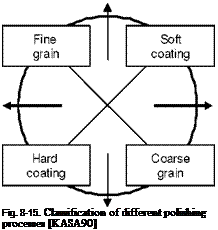In polishing, abrasive particles finely dispersed in a usually liquid medium are guided over a surface. Material removal is achieved through an interaction of chemical and mechanical mechanisms.
In chemo-mechanical polishing, material removal is the result of a chemical reaction between the workpiece surface and the polishing grains. The product of the reaction is then removed from the active zone by the polishing grain. Mechano — chemical polishing refers to a mechanical process followed by a chemical reaction. In chemical-mechanical polishing, fluids especially suited to the working material to be processed are used which react with the workpiece surface. The polishing grains then remove the reaction layer that is formed in the process. In chemo- mechanical polishing, a reaction takes place between the polishing grains and the workpiece surface which must be initiated by exceeding an energy barrier from the outside. In chemical-mechanical polishing, however, the reaction is between the fluid and the workpiece material [KOMA97].
This is made apparent in the distinction suggested by Kasai et al. between different finishing methods based on the carrier material used and the grain size of the abrasive material (Fig. 8-15) [KASA90].
![]()

 Mechanical-
Mechanical-
chemical
polishing of
sapphire
Lapping of various materials
A simple division into hard and soft carrier materials (polishing tool) and into fine-grained and coarse-grained abrasives leads to four different finishing processes used for different applications. In the polishing of glass materials, for example, a soft abrasive carrier and a fine-grained abrasive are used as a rule [KASA90].
